Jeanette was a consummate and mindful professional who always tried to give her adoring and loyal fans access to an operatic repertoire which was mostly associated until then with a social elite. It was not unusual for her to include famous arias from Gounod, Puccini, Verdi, Bizet, Donizetti, etc. in her films and her recitals. She handled her business arrangements with skill and determination and was no slouch when it came to the technical aspects of filming. In Hollywood, she was going to be known as 'The Iron Butterfly'.
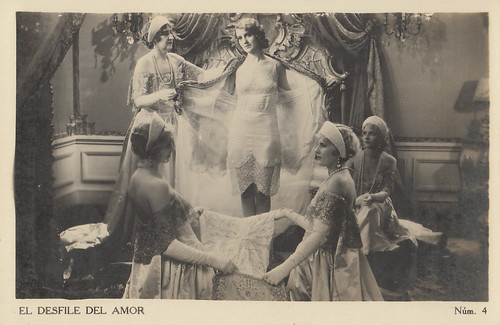
Spanish postcard, no. 4. Jeanette MacDonald in The Love Parade (Ernst Lubitsch, 1929).
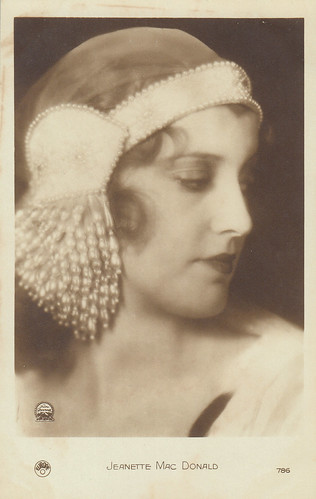
French postcard by Europe, no. 786. Photo: Films Paramount.
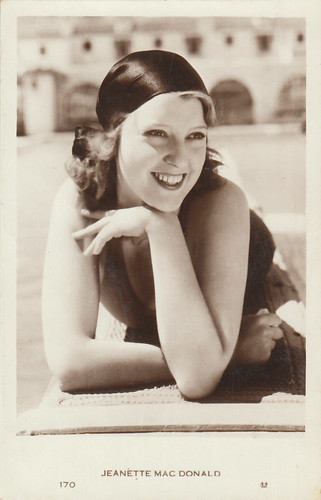
Spanish postcard by MC, Barcelona, no. 170.
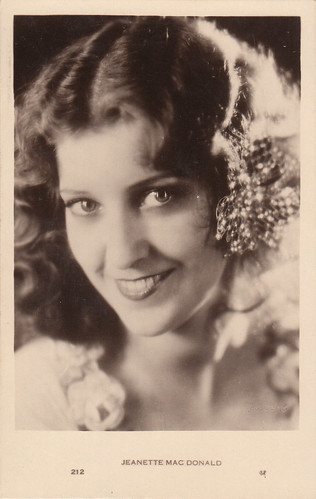
Spanish postcard by MC, Barcelona, no. 212.
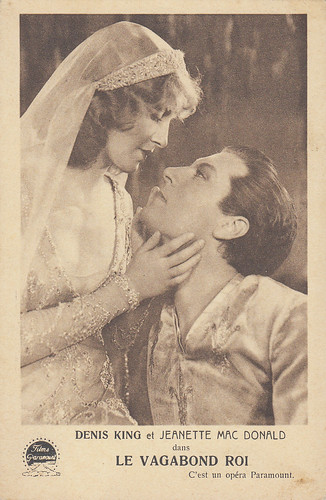
Belgian postcard. Photo: Films Paramount. Jeanette MacDonald and Dennis King in The Vagabond King (Ludwig Berger, 1930).
Jeanette MacDonald was born as Jeannette Anna McDonald on the 18th of June 1903 in Philadelphia, Pennsylvania, U.S.A. Later, she dropped one of the n’s from her first name and added an a to her surname.
She made her first public appearance, singing a religious hymn, at the age of three at a Presbyterian Church.
On the 19th of February 1909, she had three solo spots in 'Charity', a children’s opera written for a benefit performance, at the Philadelphia Academy of Music. It earned her her first favourable reviews in the local press.
From 1911 to 1913, she performed in Vaudeville with five other children in a kiddie act, 'The Six Sunny Song Birds'. She then joined 'The Seven Merry Yougsters' in 1914.
But the 'Gerry Society of New York City', which protected children from commercial exploitation, soon sued Jeanette’s parents. As a result, she had to go back to school and momentarily put her stage ambitions aside.
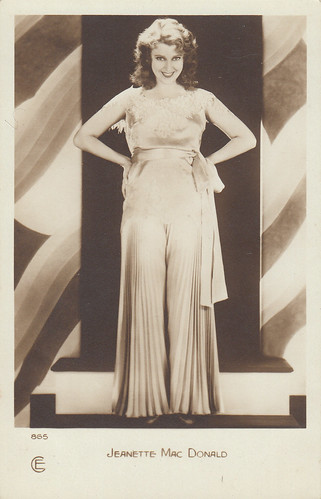
French postcard by Cinémagazine, no. 865.

French postcard by Cinémagazine, no. 895.
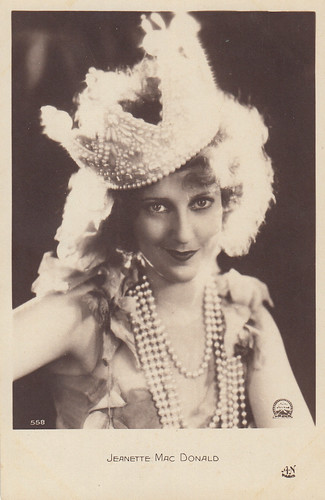
French postcard by A.N., Paris, no. 558. Photo: Paramount. Jeanette MacDonald in Let’s Go Native (Leo McCarey, 1930).

Austrian postcard by Iris Verlag, no. 6442. Photo: Max Munn Autrey / Fox. Jeanette MacDonald in Oh, for a Man! (Hamilton MacFadden, 1930).

French postcard by EDUG, no. 101. Photo: Fox Film Corp.
In 1919, Jeanette MacDonald reappeared on stage in New York in the chorus of the 'Demi-Tasse Revue'. Over the years, she worked her way up.
The Broadway revue 'A Fantastic Fricassee' got her to be favourably mentioned in the famous Billboard magazine in November 1922. When she played the second lead in 'The Magic Ring' (1923), she was noticed by the New York press. After its Broadway run, she successfully toured with it.
In the following years, she continued her upward climb. She got her first full-fledged leading role in 1926 in 'Yes, Yes Yvette', a follow-up to the popular 'No, No Nanette'. After an extensive and successful U.S. tour, which began in December 1926, it unfortunately flopped on Broadway at the end of 1927, where it only lasted 40 performances. After it had closed down, she signed in November 1927 with the famous Shubert Brothers.
They first cast her in 'The Studio Girl', which was a failure and never made it to Broadway. She then starred in 'Sunny Days', which enjoyed moderate Broadway success with a respectable run from February to May 1928. Her last two Broadway musicals for the Shuberts, 'Angela' (1928-1929) and 'Boom-Boom' (1929) didn’t draw large crowds.
Jeanette MacDonald never quite reached the first rank of Broadway stars. However, at the end of the 1920s, she had made a name for herself, was well-paid, usually received good reviews and was regarded as a pretty, talented and seasoned performer. It was only natural for Hollywood to take interest in her.
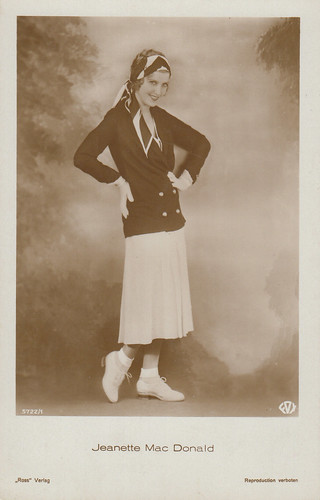
German postcard by Ross Verlag, no. 5722/1, 1930-1931. Jeanette MacDonald in Don’t Bet on Women (William K. Howard, 1930).

French autographed postcard by Studio Piaz. Autographed in September 1931, during her first European tour.
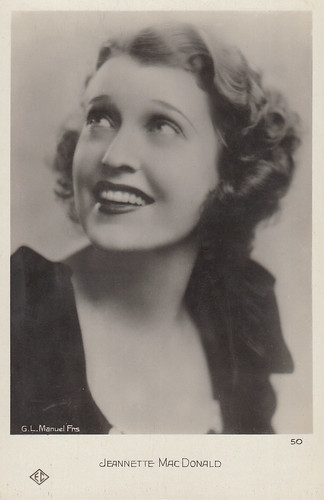
French postcard by E.C., no. 50. Photo: Irving Chidnoff (G.L. Manuel Frères is a mistake).
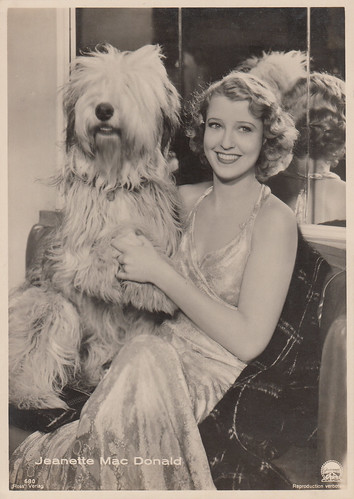
German postcard by Ross Verlag, no. 680. Photo: Paramount.
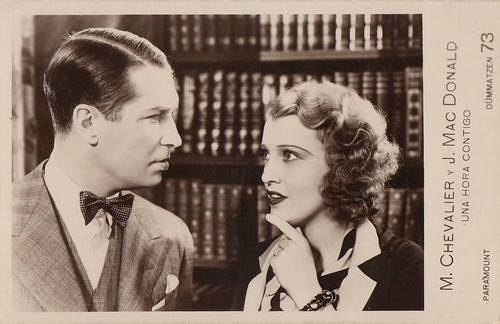
Spanish postcard by Dümmatzen, no. 73. Photo: Paramount, Jeanette MacDonald and Maurice Chevalier in One Hour with You (George Cukor, Ernst Lubitsch, 1932).
In 1928, Jeanette MacDonald was screen-tested by Paramount, which had her in mind for a role opposite Richard Dix in Nothing But the Truth. She made a favourable impression but The Shubert Brothers didn’t allow her to sign a movie contract.
In 1929, she allegedly made a second screen test, this time for Fox. Her partner was then a young actor named Archie Leach, who had a small role in the aforementioned 'Boom-Boom'. But Fox considered that neither of the two had a screen personality. It was a big mistake on their part as Jeanette soon made it in Hollywood and Archie Leach would later become famous as Cary Grant.
She got her big break when Ernst Lubitsch, who was searching for a leading lady for Maurice Chevalier in the upcoming The Love Parade, saw her 1928 Paramount test and decided that she would be perfect for the role. So, after she had left the Shuberts, she signed with Paramount. The Love Parade (1929) was a success and made her a star. It was followed by The Vagabond King (1930), which was a bit disappointing at the box office. She then signed a one-picture deal with United Artists but The Lottery Bride (1930) was a failure.
At Paramount, she was in Let’s Go Native (1930) before Ernst Lubitsch directed her again in Monte Carlo (1930), which brought her good notices. But U.S. audiences didn’t warm to Monte Carlo’s male star, Jack Buchanan, who had been imported from England. She then signed a three-picture deal with Fox, with only so-so results. She first played in Oh, for a Man! (1930) and, as musicals had gone out of vogue at the time, she then appeared in two films in which she didn’t sing, Don’t Bet on Women (1931) and Annabelle’s Affairs (1931).
Fortunately, after a successful series of recitals in France and England, she was back at Paramount and reunited with Maurice Chevalier in two classics: Ernst Lubitsch’s One Hour with You (1932), which was also filmed in French as Une heure près de toi, and Rouben Mamoulian’s Love Me Tonight (1932). Those films made better business abroad than at home, as U.S. small-city moviegoers found them too sophisticated for their taste. With no more film offers in sight, she again decided to go on tour in France, Belgium, Netherlands and Switzerland.

Spanish postcard by Dümmatzen, no. 136. Photo: Paramount.
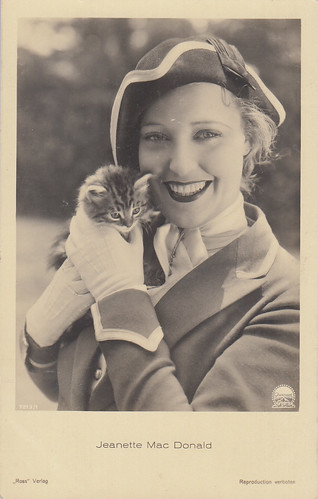
German postcard by Ross Verlag, no. 7213/1, 1932-1933. Photo: Paramount. Jeanette MacDonald in Love Me Tonight (Rouben Mamoulian, 1932).

French postcard by E.C., no. 35.
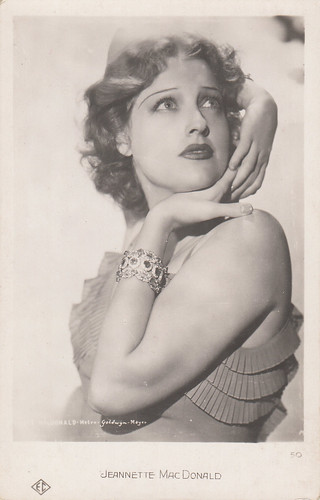
French postcard by E.C., no. 50. Photo: Metro-Goldwyn-Mayer.

German postcard by Ross Verlag, no. 8925/1, 1933-1934. Photo: Metro-Goldwyn-Mayer. Jeanette MacDonald and Maurice Chevalier in The Merry Widow (Ernst Lubitsch, 1934).
In 1933, M.G.M. signed her. Her first movie for them, The Cat and the Fiddle (1934), co-starring Ramon Novarro, didn’t reach the box office heights. Ernst Lubitsch’s prestigious The Merry Widow (1934) co-starred her with Maurice Chevalier for the last time. The two stars also appeared in the French-language version, La veuve joyeuse. The Merry Widow was especially very popular in Europe and in South America. In the U.S., it chiefly pleased refined audiences from urban areas. Because of its huge production costs, it finished in the red for M.G.M.
It soon occurred to Louis B. Mayer that Jeanette had more box-office clout in U.S. big cities and in foreign countries. So, he decided it was time to give her a warmer and less sophisticated image, which would appeal to small-town America. To achieve his goal, he convinced her to star in a film version of the popular Victor Herbert’s operetta 'Naughty Marietta', in which her leading man was a baritone M.G.M. had under contract since 1933, Nelson Eddy. It paid off, as Naughty Marietta (1935) was a massive hit.
Then, MacDonald and Eddy were reunited in Rose Marie (1936), which was an even greater success. The pair’s box-office appeal skyrocketed. Unwilling to be seen only as part of a team, she co-starred with Clark Gable and Spencer Tracy in San Francisco (1936), which became M.G.M.’s greatest moneymaker before Gone with the Wind was released in 1939.
She was back with Nelson Eddy in the very successful Maytime (1937) before co-starring with tenor Allan Jones in The Firefly (1937). Having noticed that The Firefly had made less profit than her three movies with Eddy, Louis B. Mayer again cast the duo in The Girl of the Golden West (1938) and Sweethearts (1938), which were crowd-pleasers. Next came Broadway Serenade (1939), opposite Lew Ayres, which didn’t appeal to audiences.
Afterwards, MacDonald and Eddy were paired in New Moon (1940), which did very good business, and in Bitter Sweet (1940), which author Noël Coward hated. After that, she played with Brian Aherne and with her husband, Gene Raymond, in Smilin’ Through (1940), which made more money abroad than in the U.S. Her last film with Nelson Eddy, I Married an Angel (1942), was a flop. She eventually appeared in a less expensive film than usual, Cairo (1942), but it didn’t turn into a profit. M.G.M. didn’t pick up its option on Jeanette and let her go.
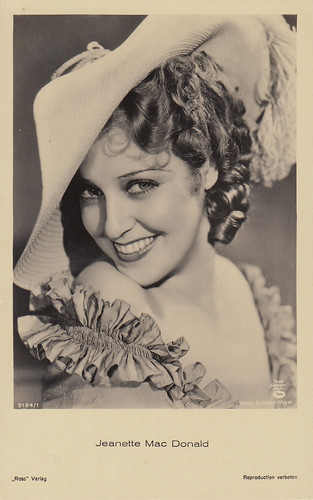
German postcard by Ross Verlag, no. 9184/1, 1935-1936. Photo: Metro-Goldwyn-Mayer. Jeanette MacDonald in Naughty Marietta (Robert Z. Leonard, W.S. Van Dyke, 1935).

Italian postcard by Ballerini & Fratini, Firenze, no. 3576. Photo: Metro-Goldwyn-Mayer. Jeanette MacDonald in Rose-Marie (W.S. Van Dyke, 1936).

German postcard by Ross Verlag, no. 9725/1, 1935-1936. Photo: Metro-Goldwyn-Mayer. Jeanette MacDonald and Clark Gable in San Francisco (W.S. Van Dyke, 1936).
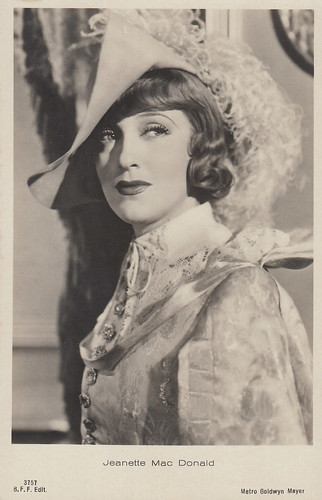
Italian postcard by Ballerini & Fratini, Firenze, no. 3757. Photo: Metro-Goldwyn-Mayer. Jeanette MacDonald in Maytime (Robert Z. Leonard, 1937).
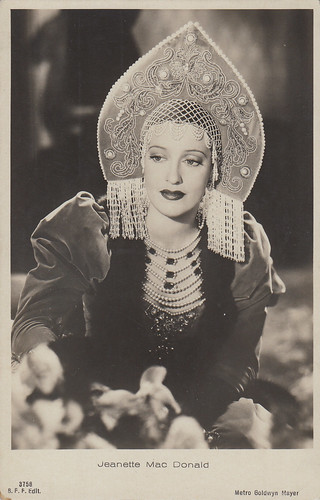
Italian postcard by Ballerini & Fratini, Firenze, no. 3758. Photo: Metro-Goldwyn-Mayer. Jeanette MacDonald in Maytime (Robert Z. Leonard, 1937).
In 1944, Jeanette MacDonald sang the standards 'Beyond the Blue Horizon' and 'I’ll See You in My Dreams' in the star-studded Follow the Boys, a wartime morale booster produced by Universal. A few years later, producer Joe Pasternak enticed her to come back to M.G.M. for the musical Three Daring Daughters (1948). Audiences liked it but it had been such a costly production that, in the end, there was no financial gain for M.G.M. Her filmography ended with playing a widowed concert singer in The Sun Comes Up (1949), in which she shared the spotlight with child actor Claude Jarman Jr. and Lassie the Dog.
Since her last European tour in 1933, Jeanette had focused on her film career. At the end of the 1930s, she decided it was time to perform again in front of live audiences. So, from 1939 to the end of the 1950s, she toured in live concerts all around the U.S.A. She even tried her hand at opera in two of Charles Gounod’s works. She sang 'Roméo et Juliette' in several Canadian cities in 1943, in Chicago and Milwaukee in 1944 and in Cincinnati in 1945 and 'Faust' in Chicago in 1944 and 1945, in Cincinnati in 1945 and in Philadelphia in 1951.
More surprisingly, she had her own nightclub act in Las Vegas at the Sahara in 1953 and 1957, at the Sands in 1953, and in Los Angeles at the Cocoanut Grove in 1954. In 1951, she went on a four-month tour with Gene Raymond, in a revival of Ferenc Molnar’s 'The Guardsman', but it closed before reaching Broadway. She was also featured in summer stock productions of 'Bitter Sweet' in 1954, 1955 and 1959 and 'The King and I' in 1956.
Jeanette considered that radio greatly furthered people’s access to music and had her own weekly show on CBS, Vicks Open House, from September 1937 to March 1938. In 1950, she made her television debut in the musical program The Voice of Firestone. It was followed by other appearances, such as Ed Sullivan’s Toast of the Town in 1951 or The Jackie Gleason Show in 1953.
In 1957, Jeanette and Nelson Eddy sang a medley of songs in Patti Paige’s TV show The Big Record. The positive reception from the public prompted RCA record company to sign the duo for an album. Their LP, which mostly consisted of new recordings of standards from their films, was released in 1959 and went gold.
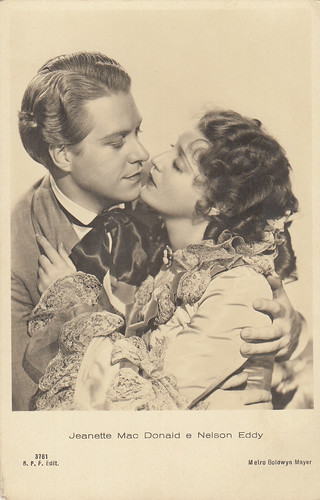
Italian postcard by Ballerini & Fratini, Firenze, no. 3761. Photo: Metro Goldwyn Mayer. Jeanette MacDonald and Nelson Eddy in Maytime (Robert Z. Leonard, 1937).

German postcard by Ross Verlag, no. A 1106/1, 1937-1938. Photo: Metro Goldwyn Mayer. Jeanette MacDonald and Nelson Eddy in Maytime (Robert Z. Leonard, 1937).
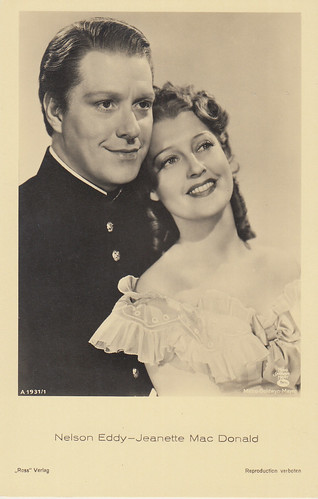
German postcard by Ross Verlag, no. A 1931/1, 1937-1938. Photo: Metro Goldwyn Mayer. Jeanette MacDonald and Nelson Eddy in The Girl of the Golden West (Robert Z. Leonard, 1938).
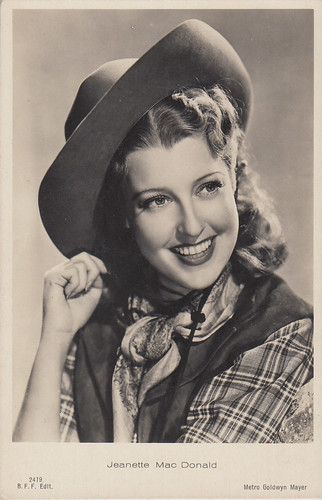
Italian postcard by Ballerini & Fratini, Firenze, no. 3576. Photo: Metro Goldwyn Mayer. Jeanette MacDonald in The Girl of the Golden West (Robert Z. Leonard, 1938).

Italian postcard by Ballerini & Fratini, Firenze, no. 2794. Photo: Metro Goldwyn Mayer.
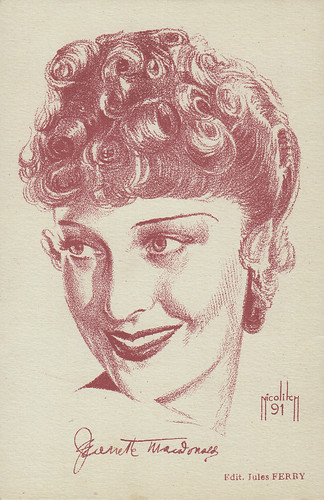
French postcard by Editions Jules Ferry, no. 91.
Jeanette MacDonald’s first serious suitor was Jack Ohmeis, who came from a wealthy family and to whom she was engaged for some time in the 1920’s. In 1928, she embarked on a romance with Robert Ritchie, who acted as her manager, which lasted until the mid-1930s.
In 1935, she began dating actor Gene Raymond and they married in June 1937.
The first half of the 1960s saw MacDonald being plagued with health problems and she passed away on the 14th of January 1965.
According to some sources, especially the 1994 book 'Sweethearts', Jeanette MacDonald and Nelson Eddy would have had a long on-and-off love affair for many years, before and after their respective marriages. She even would have been pregnant several times from Eddy, but would have miscarried.
Those assertions have stirred up controversy and are far from eliciting unanimity among fans and biographers. Are they utter nonsense and pure fantasy? We’ll let you form your own opinion.

British postcard in the Colourgraph Series, London, no. C265a. Photo: Metro Goldwyn Mayer. Jeanette MacDonald in Sweethearts (W.S. Van Dyke, Robert Z. Leonard, 1938).
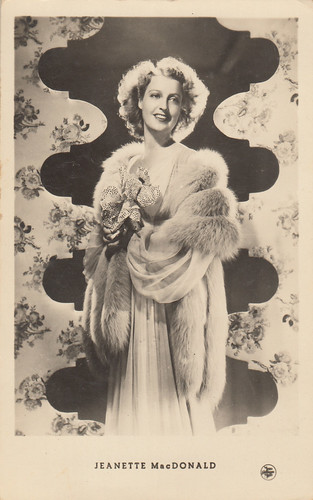
Spanish postcard. Photo: Metro Goldwyn Mayer.

British postcard in the Colourgraph Series, London, no. C395. Photo: Metro Goldwyn Mayer. Jeanette MacDonald in New Moon (Robert Z. Leonard, W.S. Van Dyke, 1940).

Dutch postcard by S. & v. H. A. Photo: Metro Goldwyn Mayer. Jeanette MacDonald and Gene Raymond.
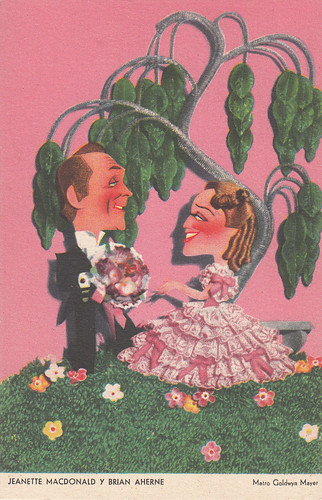
Spanish postcard by I.G. Viladot S/L, Barcelona. Caricature by Jacques Kapralik / Metro Goldwyn Mayer. Jeanette MacDonald and Brian Aherne.
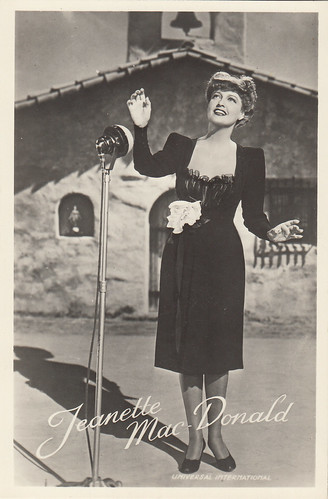
Dutch postcard no. 3214. Photo: Universal International. Jeanette MacDonald in Follow the Boys (A. Edward Sutherland, John Rawlins, 1944).
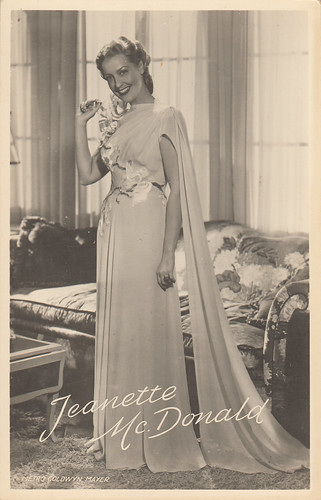
Dutch postcard by Foto Archief Film en Toneel, no. 3460. Photo: Metro Goldwyn Mayer. Jeanette MacDonald in Three Daring Daughters (Fred M. Wilcox, 1948).
Text and postcards: Marlene Pilaete.

Spanish postcard, no. 4. Jeanette MacDonald in The Love Parade (Ernst Lubitsch, 1929).

French postcard by Europe, no. 786. Photo: Films Paramount.

Spanish postcard by MC, Barcelona, no. 170.

Spanish postcard by MC, Barcelona, no. 212.

Belgian postcard. Photo: Films Paramount. Jeanette MacDonald and Dennis King in The Vagabond King (Ludwig Berger, 1930).
A musical childhood
Jeanette MacDonald was born as Jeannette Anna McDonald on the 18th of June 1903 in Philadelphia, Pennsylvania, U.S.A. Later, she dropped one of the n’s from her first name and added an a to her surname.
She made her first public appearance, singing a religious hymn, at the age of three at a Presbyterian Church.
On the 19th of February 1909, she had three solo spots in 'Charity', a children’s opera written for a benefit performance, at the Philadelphia Academy of Music. It earned her her first favourable reviews in the local press.
From 1911 to 1913, she performed in Vaudeville with five other children in a kiddie act, 'The Six Sunny Song Birds'. She then joined 'The Seven Merry Yougsters' in 1914.
But the 'Gerry Society of New York City', which protected children from commercial exploitation, soon sued Jeanette’s parents. As a result, she had to go back to school and momentarily put her stage ambitions aside.

French postcard by Cinémagazine, no. 865.

French postcard by Cinémagazine, no. 895.

French postcard by A.N., Paris, no. 558. Photo: Paramount. Jeanette MacDonald in Let’s Go Native (Leo McCarey, 1930).

Austrian postcard by Iris Verlag, no. 6442. Photo: Max Munn Autrey / Fox. Jeanette MacDonald in Oh, for a Man! (Hamilton MacFadden, 1930).

French postcard by EDUG, no. 101. Photo: Fox Film Corp.
Her stage career in the 20s
In 1919, Jeanette MacDonald reappeared on stage in New York in the chorus of the 'Demi-Tasse Revue'. Over the years, she worked her way up.
The Broadway revue 'A Fantastic Fricassee' got her to be favourably mentioned in the famous Billboard magazine in November 1922. When she played the second lead in 'The Magic Ring' (1923), she was noticed by the New York press. After its Broadway run, she successfully toured with it.
In the following years, she continued her upward climb. She got her first full-fledged leading role in 1926 in 'Yes, Yes Yvette', a follow-up to the popular 'No, No Nanette'. After an extensive and successful U.S. tour, which began in December 1926, it unfortunately flopped on Broadway at the end of 1927, where it only lasted 40 performances. After it had closed down, she signed in November 1927 with the famous Shubert Brothers.
They first cast her in 'The Studio Girl', which was a failure and never made it to Broadway. She then starred in 'Sunny Days', which enjoyed moderate Broadway success with a respectable run from February to May 1928. Her last two Broadway musicals for the Shuberts, 'Angela' (1928-1929) and 'Boom-Boom' (1929) didn’t draw large crowds.
Jeanette MacDonald never quite reached the first rank of Broadway stars. However, at the end of the 1920s, she had made a name for herself, was well-paid, usually received good reviews and was regarded as a pretty, talented and seasoned performer. It was only natural for Hollywood to take interest in her.

German postcard by Ross Verlag, no. 5722/1, 1930-1931. Jeanette MacDonald in Don’t Bet on Women (William K. Howard, 1930).

French autographed postcard by Studio Piaz. Autographed in September 1931, during her first European tour.

French postcard by E.C., no. 50. Photo: Irving Chidnoff (G.L. Manuel Frères is a mistake).

German postcard by Ross Verlag, no. 680. Photo: Paramount.

Spanish postcard by Dümmatzen, no. 73. Photo: Paramount, Jeanette MacDonald and Maurice Chevalier in One Hour with You (George Cukor, Ernst Lubitsch, 1932).
First years in Hollywood
In 1928, Jeanette MacDonald was screen-tested by Paramount, which had her in mind for a role opposite Richard Dix in Nothing But the Truth. She made a favourable impression but The Shubert Brothers didn’t allow her to sign a movie contract.
In 1929, she allegedly made a second screen test, this time for Fox. Her partner was then a young actor named Archie Leach, who had a small role in the aforementioned 'Boom-Boom'. But Fox considered that neither of the two had a screen personality. It was a big mistake on their part as Jeanette soon made it in Hollywood and Archie Leach would later become famous as Cary Grant.
She got her big break when Ernst Lubitsch, who was searching for a leading lady for Maurice Chevalier in the upcoming The Love Parade, saw her 1928 Paramount test and decided that she would be perfect for the role. So, after she had left the Shuberts, she signed with Paramount. The Love Parade (1929) was a success and made her a star. It was followed by The Vagabond King (1930), which was a bit disappointing at the box office. She then signed a one-picture deal with United Artists but The Lottery Bride (1930) was a failure.
At Paramount, she was in Let’s Go Native (1930) before Ernst Lubitsch directed her again in Monte Carlo (1930), which brought her good notices. But U.S. audiences didn’t warm to Monte Carlo’s male star, Jack Buchanan, who had been imported from England. She then signed a three-picture deal with Fox, with only so-so results. She first played in Oh, for a Man! (1930) and, as musicals had gone out of vogue at the time, she then appeared in two films in which she didn’t sing, Don’t Bet on Women (1931) and Annabelle’s Affairs (1931).
Fortunately, after a successful series of recitals in France and England, she was back at Paramount and reunited with Maurice Chevalier in two classics: Ernst Lubitsch’s One Hour with You (1932), which was also filmed in French as Une heure près de toi, and Rouben Mamoulian’s Love Me Tonight (1932). Those films made better business abroad than at home, as U.S. small-city moviegoers found them too sophisticated for their taste. With no more film offers in sight, she again decided to go on tour in France, Belgium, Netherlands and Switzerland.

Spanish postcard by Dümmatzen, no. 136. Photo: Paramount.

German postcard by Ross Verlag, no. 7213/1, 1932-1933. Photo: Paramount. Jeanette MacDonald in Love Me Tonight (Rouben Mamoulian, 1932).

French postcard by E.C., no. 35.

French postcard by E.C., no. 50. Photo: Metro-Goldwyn-Mayer.

German postcard by Ross Verlag, no. 8925/1, 1933-1934. Photo: Metro-Goldwyn-Mayer. Jeanette MacDonald and Maurice Chevalier in The Merry Widow (Ernst Lubitsch, 1934).
M.G.M.’s bright star
In 1933, M.G.M. signed her. Her first movie for them, The Cat and the Fiddle (1934), co-starring Ramon Novarro, didn’t reach the box office heights. Ernst Lubitsch’s prestigious The Merry Widow (1934) co-starred her with Maurice Chevalier for the last time. The two stars also appeared in the French-language version, La veuve joyeuse. The Merry Widow was especially very popular in Europe and in South America. In the U.S., it chiefly pleased refined audiences from urban areas. Because of its huge production costs, it finished in the red for M.G.M.
It soon occurred to Louis B. Mayer that Jeanette had more box-office clout in U.S. big cities and in foreign countries. So, he decided it was time to give her a warmer and less sophisticated image, which would appeal to small-town America. To achieve his goal, he convinced her to star in a film version of the popular Victor Herbert’s operetta 'Naughty Marietta', in which her leading man was a baritone M.G.M. had under contract since 1933, Nelson Eddy. It paid off, as Naughty Marietta (1935) was a massive hit.
Then, MacDonald and Eddy were reunited in Rose Marie (1936), which was an even greater success. The pair’s box-office appeal skyrocketed. Unwilling to be seen only as part of a team, she co-starred with Clark Gable and Spencer Tracy in San Francisco (1936), which became M.G.M.’s greatest moneymaker before Gone with the Wind was released in 1939.
She was back with Nelson Eddy in the very successful Maytime (1937) before co-starring with tenor Allan Jones in The Firefly (1937). Having noticed that The Firefly had made less profit than her three movies with Eddy, Louis B. Mayer again cast the duo in The Girl of the Golden West (1938) and Sweethearts (1938), which were crowd-pleasers. Next came Broadway Serenade (1939), opposite Lew Ayres, which didn’t appeal to audiences.
Afterwards, MacDonald and Eddy were paired in New Moon (1940), which did very good business, and in Bitter Sweet (1940), which author Noël Coward hated. After that, she played with Brian Aherne and with her husband, Gene Raymond, in Smilin’ Through (1940), which made more money abroad than in the U.S. Her last film with Nelson Eddy, I Married an Angel (1942), was a flop. She eventually appeared in a less expensive film than usual, Cairo (1942), but it didn’t turn into a profit. M.G.M. didn’t pick up its option on Jeanette and let her go.

German postcard by Ross Verlag, no. 9184/1, 1935-1936. Photo: Metro-Goldwyn-Mayer. Jeanette MacDonald in Naughty Marietta (Robert Z. Leonard, W.S. Van Dyke, 1935).

Italian postcard by Ballerini & Fratini, Firenze, no. 3576. Photo: Metro-Goldwyn-Mayer. Jeanette MacDonald in Rose-Marie (W.S. Van Dyke, 1936).

German postcard by Ross Verlag, no. 9725/1, 1935-1936. Photo: Metro-Goldwyn-Mayer. Jeanette MacDonald and Clark Gable in San Francisco (W.S. Van Dyke, 1936).

Italian postcard by Ballerini & Fratini, Firenze, no. 3757. Photo: Metro-Goldwyn-Mayer. Jeanette MacDonald in Maytime (Robert Z. Leonard, 1937).

Italian postcard by Ballerini & Fratini, Firenze, no. 3758. Photo: Metro-Goldwyn-Mayer. Jeanette MacDonald in Maytime (Robert Z. Leonard, 1937).
Her last films, live appearances, radio and television
In 1944, Jeanette MacDonald sang the standards 'Beyond the Blue Horizon' and 'I’ll See You in My Dreams' in the star-studded Follow the Boys, a wartime morale booster produced by Universal. A few years later, producer Joe Pasternak enticed her to come back to M.G.M. for the musical Three Daring Daughters (1948). Audiences liked it but it had been such a costly production that, in the end, there was no financial gain for M.G.M. Her filmography ended with playing a widowed concert singer in The Sun Comes Up (1949), in which she shared the spotlight with child actor Claude Jarman Jr. and Lassie the Dog.
Since her last European tour in 1933, Jeanette had focused on her film career. At the end of the 1930s, she decided it was time to perform again in front of live audiences. So, from 1939 to the end of the 1950s, she toured in live concerts all around the U.S.A. She even tried her hand at opera in two of Charles Gounod’s works. She sang 'Roméo et Juliette' in several Canadian cities in 1943, in Chicago and Milwaukee in 1944 and in Cincinnati in 1945 and 'Faust' in Chicago in 1944 and 1945, in Cincinnati in 1945 and in Philadelphia in 1951.
More surprisingly, she had her own nightclub act in Las Vegas at the Sahara in 1953 and 1957, at the Sands in 1953, and in Los Angeles at the Cocoanut Grove in 1954. In 1951, she went on a four-month tour with Gene Raymond, in a revival of Ferenc Molnar’s 'The Guardsman', but it closed before reaching Broadway. She was also featured in summer stock productions of 'Bitter Sweet' in 1954, 1955 and 1959 and 'The King and I' in 1956.
Jeanette considered that radio greatly furthered people’s access to music and had her own weekly show on CBS, Vicks Open House, from September 1937 to March 1938. In 1950, she made her television debut in the musical program The Voice of Firestone. It was followed by other appearances, such as Ed Sullivan’s Toast of the Town in 1951 or The Jackie Gleason Show in 1953.
In 1957, Jeanette and Nelson Eddy sang a medley of songs in Patti Paige’s TV show The Big Record. The positive reception from the public prompted RCA record company to sign the duo for an album. Their LP, which mostly consisted of new recordings of standards from their films, was released in 1959 and went gold.

Italian postcard by Ballerini & Fratini, Firenze, no. 3761. Photo: Metro Goldwyn Mayer. Jeanette MacDonald and Nelson Eddy in Maytime (Robert Z. Leonard, 1937).

German postcard by Ross Verlag, no. A 1106/1, 1937-1938. Photo: Metro Goldwyn Mayer. Jeanette MacDonald and Nelson Eddy in Maytime (Robert Z. Leonard, 1937).

German postcard by Ross Verlag, no. A 1931/1, 1937-1938. Photo: Metro Goldwyn Mayer. Jeanette MacDonald and Nelson Eddy in The Girl of the Golden West (Robert Z. Leonard, 1938).

Italian postcard by Ballerini & Fratini, Firenze, no. 3576. Photo: Metro Goldwyn Mayer. Jeanette MacDonald in The Girl of the Golden West (Robert Z. Leonard, 1938).

Italian postcard by Ballerini & Fratini, Firenze, no. 2794. Photo: Metro Goldwyn Mayer.

French postcard by Editions Jules Ferry, no. 91.
Her private life
Jeanette MacDonald’s first serious suitor was Jack Ohmeis, who came from a wealthy family and to whom she was engaged for some time in the 1920’s. In 1928, she embarked on a romance with Robert Ritchie, who acted as her manager, which lasted until the mid-1930s.
In 1935, she began dating actor Gene Raymond and they married in June 1937.
The first half of the 1960s saw MacDonald being plagued with health problems and she passed away on the 14th of January 1965.
According to some sources, especially the 1994 book 'Sweethearts', Jeanette MacDonald and Nelson Eddy would have had a long on-and-off love affair for many years, before and after their respective marriages. She even would have been pregnant several times from Eddy, but would have miscarried.
Those assertions have stirred up controversy and are far from eliciting unanimity among fans and biographers. Are they utter nonsense and pure fantasy? We’ll let you form your own opinion.

British postcard in the Colourgraph Series, London, no. C265a. Photo: Metro Goldwyn Mayer. Jeanette MacDonald in Sweethearts (W.S. Van Dyke, Robert Z. Leonard, 1938).

Spanish postcard. Photo: Metro Goldwyn Mayer.

British postcard in the Colourgraph Series, London, no. C395. Photo: Metro Goldwyn Mayer. Jeanette MacDonald in New Moon (Robert Z. Leonard, W.S. Van Dyke, 1940).

Dutch postcard by S. & v. H. A. Photo: Metro Goldwyn Mayer. Jeanette MacDonald and Gene Raymond.

Spanish postcard by I.G. Viladot S/L, Barcelona. Caricature by Jacques Kapralik / Metro Goldwyn Mayer. Jeanette MacDonald and Brian Aherne.

Dutch postcard no. 3214. Photo: Universal International. Jeanette MacDonald in Follow the Boys (A. Edward Sutherland, John Rawlins, 1944).

Dutch postcard by Foto Archief Film en Toneel, no. 3460. Photo: Metro Goldwyn Mayer. Jeanette MacDonald in Three Daring Daughters (Fred M. Wilcox, 1948).
Text and postcards: Marlene Pilaete.
3 comments:
You list Nelson Eddy as a tenor but he was a baritone.
Thanks, we've corrected it.
Very informative - thank you
Post a Comment